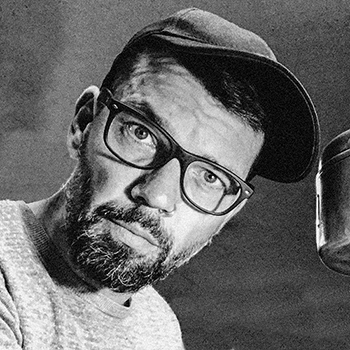Intrigued by places that were once full of life and loved by their inhabitants and builders, Leffe’s drawings are based on real, existing places or objects. Architecture, pieces of machinery, planes, helicopters and vehicles that were left to decay; objects that were invented and served a purpose, built with the hands of real people. In Leffe’s universe, these people are no longer there and long forgotten. But take a good look and you can see their demons are still thriving, breeding an alternative future world.
His latest work contains a political undertone which cannot be ignored. For instance the work Sonic Boom depicting an F16 aircraft. The work Under the Dark Skies where a Patriot air defence system spitting out Demons; hence, Ukraine. Under the Surface pictures a fantasy submarine roaring the seas of a geopolitical war.
A more sarcastic view on Dutch governance is embedded in the work Lelystad Airport, the airport that never came to be. The work Slochteren is about closing down the largest gas field of Europe located in Groningen due to many earthquakes in the region. Damaging around 100.000 houses in the past decade. Leaving the people of Groningen in despair.
“Most people see demons as their wildest fears while others seem to enjoy them but the lucky ones have both.” Leffe Goldstein always starts sketching with pencil but the finished black and white works are drawn digitally. He uses the sketch as an under-layer and works endlessly on details to bring the demons to life. When finished the drawings are printed as a silkscreen print, or a Giclée.
Leffe Goldstein is a Graphic Artist living and working in Utrecht, the Netherlands for over 25 years. Goldstein’s curiosity about utilities, transportation, and infrastructure networks started by watching his father work on architectural blueprints for power stations and other large utility buildings when his father worked for a large Dutch construction company. This company built for the Dutch government in the 70's and are still doing so today.
“It’s fascinating how all these infrastructure networks have evolved for the good and the bad over the last few centuries. Demolished and rebuilt. From the old road networks, shipping routes to rail transport, later airport hubs. And all the utilities that have to be built to support these networks. Now you have the digital networks that are very tangible because the so-called cloud really doesn’t exist. All this data is stored in huge server warehouses all over the world and they consume enormous amounts of energy. And guess what, these are all connected by enormous amounts of cables that lie on the ocean floor and in the ground. All these networks still have to be maintained under often harsh conditions. It’s fascinating and inspiring when you think about it and it shouldn’t be taken for granted.”
During his many travels through Japan, Leffe became familiar with Japanese folklore in which the concept of Tsukumogami appears. A Tsukumogami (付喪神) is a fictional being in Japanese mythology and folklore, based on everyday objects. According to Japanese folklore, an object of everyday use gains its own life and consciousness when it is 99 years old, and changes into a Tsukomogami. The kanji for Tsukomogami are therefore the same as those for “99 gods”.
Tsukumogami belong to the yokai (demons). Any object can become a Tsukumogami. They are seen as spirits and supernatural beings.
Yōkai have very different forms. They can look like people, animals often with wings, objects, personifications of a natural phenomenon or a combination of several of these things (such as the Kappa and Tengu). They often have supernatural or spiritual powers. Their behaviour also varies greatly. Not all Yōkai are evil. Some try to avoid contact with people as much as possible, or can even be helpful. Other Yōkai seek out as many people as possible. They are seen as evil, but can also be the embodiment of a force of nature. Yōkai often appear in Leffe's drawings accompanying his subjects.

レフ・ゴールドスタインは、オランダのユトレヒトに 25 年以上住み、活動しているグラフィック アーティストです
レフ・ゴールドスタインの「夢見る悪魔たち」は、もう一つの未来を提示しています。これらの絵は、人間が存在しない不条理な世界、悪魔だけが生き残った世界を白黒で描いています。
かつて生命に満ち溢れ、住人や建築者たちに愛されていた場所に魅了されたレフの絵は、実在する場所や物に基づいています。朽ち果てた建築物、機械、飛行機、ヘリコプター、乗り物。それらは、現実の人々の手によって発明され、ある目的を果たした物です。レフの描く世界において、これらの人々はもはや存在せず、長らく忘れ去られています。しかし、よく見てみると、彼らの悪魔たちは今もなお繁栄し、もう一つの未来の世界を育んでいることがわかります。
レフは日本を幾度となく旅する中で、付喪神という概念が登場する日本の民話に親しんでいきました。付喪神とは、日本の神話や民話に登場する、日常の物をモデルにした架空の存在です。日本の民話によると、日用品は99歳になると生命と意識を得て、付喪神(つきもがみ)に変化すると言われています。そのため、「付喪神」という漢字は「九十九神」と同じ意味です。
付喪神は妖怪の一種です。どんな物でも付喪神になる可能性があり、精霊や超自然的な存在として捉えられています。
妖怪の姿は実に様々です。人、動物、物、自然現象の擬人化、あるいはこれらの組み合わせ(河童や天狗など)など、様々な姿があります。妖怪は超自然的な力や霊的な力を持つ場合が多く、行動も多様です。すべての妖怪が邪悪なわけではありません。できるだけ人との接触を避けようとする妖怪や、時には役に立つ妖怪もいます。また、できるだけ多くの人を狙う妖怪もいます。
日本の民話で最もよく知られているものの一つです。鬼は赤、青、茶、黒の肌と二本の角を持つ鬼です。妖怪はしばしば邪悪な存在として描かれるが、自然の力の化身とも言える。
レフの作品には、妖怪が題材に添えられた絵が数多く登場する。
ゴールドスタインが公共施設、交通機関、インフラ網に興味を持ったのは、父親がオランダの大手建設会社に勤めていた頃、発電所やその他の大規模な公共施設の設計図を作成するのを見ていたことがきっかけだった。この会社は1970年代にオランダ政府向けの建設工事を手掛け、現在も建設を続けている。
「過去数世紀にわたり、インフラネットワークが、良い面も悪い面も含め、どのように進化してきたかは実に興味深いものです。破壊され、そして再建されてきました。古い道路網から海路、鉄道輸送、そして後には空港ハブ。そして、これらのネットワークを支えるために建設されなければならないあらゆる公共設備。今や、いわゆるクラウドが存在しないがゆえに、デジタルネットワークは非常に具体的なものとなっています。あらゆるデータは世界中に点在する巨大なサーバー倉庫に保存され、膨大なエネルギーを消費しています。そして、これらはすべて、海底や地中に敷設された膨大な量のケーブルで繋がれています。これらのネットワークは、依然としてしばしば過酷な条件下で維持管理されなければなりません。考えてみると、実に魅力的で刺激的なことです。そして、それを当然のことと見なすべきではありません。」
彼の最新作には、無視できない政治的な含意が込められています。例えば、F16戦闘機を描いた作品「ソニック・ブーム」。パトリオット防空システムが悪魔を吐き出す作品「アンダー・ザ・ダーク・スカイズ」。つまり、ウクライナです。 「アンダー・ザ・サーフェス」は、地政学的な戦争の海を轟音とともに航行する幻想的な潜水艦を描いています。
オランダ統治に対する皮肉な視点は、実現しなかった空港「レリスタット空港」に込められています。「スロッホテレン」は、フローニンゲンにあるヨーロッパ最大のガス田が、この地域で頻発する地震のために閉鎖されることをテーマにしています。過去10年間で約10万戸の家屋が被害を受け、フローニンゲンの人々は絶望に陥っています。
「ほとんどの人は悪魔を最も恐ろしいものと考えますが、中には悪魔を楽しむ人もいます。しかし、幸運な人は両方を手にしています。」レッフェ・ゴールドスタインは常に鉛筆でスケッチを始めますが、完成した白黒作品はデジタルで描かれます。彼はスケッチを下絵として使い、悪魔に命を吹き込むために細部にまでこだわって作業を進めます。完成した絵はシルクスクリーン、またはジクレー版画として印刷されます。
What is a Giclée print?
Giclée (/ʒiːˈkleɪ/ zhee-KLAY) is a neologism, ultimately derived from the French word gicleur, coined in 1991 by printmaker Jack Duganne for fine art digital prints made using inkjet printers. The name was originally applied to fine art prints created on a modified Iris printer in a process invented in the late 1980s. It has since been used widely to mean any fine-art printing, usually archival, printed by inkjet. It is often used by artists, galleries, and print shops for their high quality printing. (Source: Wikipedia)What is a Silkscreen print, Screen printing is a printing technique where a mesh is used to transfer ink (or dye) onto a substrate, except in areas made impermeable to the ink by a blocking stencil. A blade or squeegee is moved across the screen to fill the open mesh apertures with ink, and a reverse stroke then causes the screen to touch the substrate momentarily along a line of contact. This causes the ink to wet the substrate and be pulled out of the mesh apertures as the screen springs back after the blade has passed. One colour is printed at a time, so several screens can be used to produce a multi-coloured image or design.
Traditionally, silk was used in the process. Currently, synthetic threads are commonly used in the screen printing process. The most popular mesh in general use is made of polyester. There are special-use mesh materials of nylon and stainless steel available to the screen-printer. There are also different types of mesh size which will determine the outcome and look of the finished design on the material.
The technique is used not only for garment printing but for printing on many other substances, including decals, clock and watch faces, balloons, and many other products. Advanced uses include laying down conductors and resistors in multi-layer circuits using thin ceramic layers as the substrate.